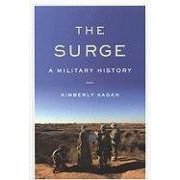
By Kimberly Kagan
Book Description: Understanding the role of combat in the Iraq war is essential for both the American people and the U.S. military. Recognizing the objectives of both sides and the plans developed to attain those objectives provides the context for understanding the war. The Surge is an effort to provide such a framework to help understand not only where we have been, but also what happens as we move forward.
Book Review: Turning the Tide Of Battle - Brendan Simms, Wall Street Journal.
... "The Surge" challenges existing accounts in two ways. First, although Ms. Kagan is rightly respectful of Gen. David Petraeus, who led American forces during the surge, she avoids celebrating his genius at the expense of other important figures. She draws attention to the pivotal role played by Lt. Gen. Ray Odierno, who commanded the day-to-day operations of the Multi-National Corps in Iraq. She shows him helping to ensure that co-operating tribal forces submit fingerprints, weapons serial numbers and family details that would make it difficult for them to take up arms again. It was Lt. Gen. Odierno who executed Operation Phantom Thunder in June 2007, synchronized operations that, as he told Ms. Kagan, aimed to "eliminate accelerants to Baghdad violence from enemy support zones." Other key players include Col. J.B. Burton, commander of the Dagger Brigade that drove the insurgents out of northwest Baghdad, and David Sutherland, whose combat team pacified the eastern province of Diyala. Ms. Kagan does not mention -- though she might have -- the analysts who helped the U.S. to rethink its counterinsurgency strategy, such as John Nagl and David Kilcullen.
Second, Ms. Kagan skewers the notion that the surge marked a shift from unreflective war-fighting to a "smarter" strategy that combined military and civil elements. This notion, in its extreme form, holds that the additional brigades were a relatively minor factor in a process driven primarily by a political change of heart among former insurgents. Ms. Kagan shows the opposite to have been the case...
Read more of the review at The Wall Street Journal.
Comments
This review is ridiculous. It (and, by inference, Kagan's book) implies a definition of warfighting that is at odds with understanding the nature of COIN warfare.
Personally, I am sick to the eye teeth of Think tank 'experts' and journalists who spend a few days (or maybe weeks) in the Green Zone or sheltered with the 3 or 4 star bubble on their 'Iraq experience'and then presume to offer us their 'unique insights' of war when all they are really doing is pushing partisan or personal promotion.
100% hindsight and narrative is neither expertise or useful. For every Carter Malkasian or Daniel Marston who actually help those of us in uniform there seems to be several dozen self serving experts with an eye on self promotion and the next OPED or book deal. I am over it.
There are a couple of books out, now, about the surge. The other one I can think of right off the bat is Tom Rick's the Gamble. I think it would be interesting to get more information from "Joe", that E6 or 2LT who had responsibility for patrolling the AO's. I would like for one of those guys to write a book. I would like for them to tell the story of how, pre-surge, one infantry battalion had responsibility for all of West Rasheed, Baghdad. Driving through the AO was the best you could do because there weren't enough soldiers to hold it. When the surge kicked in there were finally enough soldiers to do the job.
Were 5 BCT's a "minor" player?
I guess that's all a matter of perspective. When you're "Joe" it was a big deal.
There is nothing significantly new in the book that hasn't already been said in other like-books by Ricks, Robinson, et al.
Moreover the sub-title of the book is misleading in calling it a "history." In a sense the book is a half-history because it (like Ricks and Robinson) is one-sided. A perusal of Dr Kagan's endnotes at the back of the book shows that it was written primarily from American news releases and reports, official statements and memos, after-the-fact speeches by key players, and interviews. The book does not however rely on Iraqi sources to support the sweeping conclusions about effects that the book makes. To argue that the Surge worked and that American combat actions were the primary cause for the lowering of violence in Iraq that began in the late summer of 2007 would require supporting primary evidence from the enemy side and most importantly from the Iraqi population. The book therefore lacks these primary, Arabic sources and until better histories and accounts are written the story of the Surge and its effects will remain incomplete and still largely contested. Dr Kagan may be right, but she does not prove her assertions through adequate historical evidence and argument.
There is a fundamental difference between historical correlation of events and causative factors that produced those events. Good historians and students of war and conflict should understand this most basic point.
